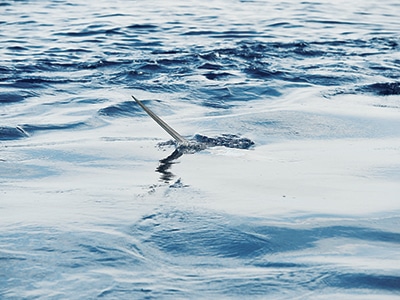
Jon Pilcher had a vision: If they catch swordfish on the bottom in 1,500 feet of water off Florida during the day, we should be able to do the same in the Northeast Canyons. An emergency-room doctor by day and an offshore fisherman by passion, Jon spent years chartering and learning deep-dropping techniques for swordfish that were first pioneered in Florida. I was his neighbor and friend — and a fishing buddy with the right boat — so I became one of his partners in the passion to make that vision a reality.
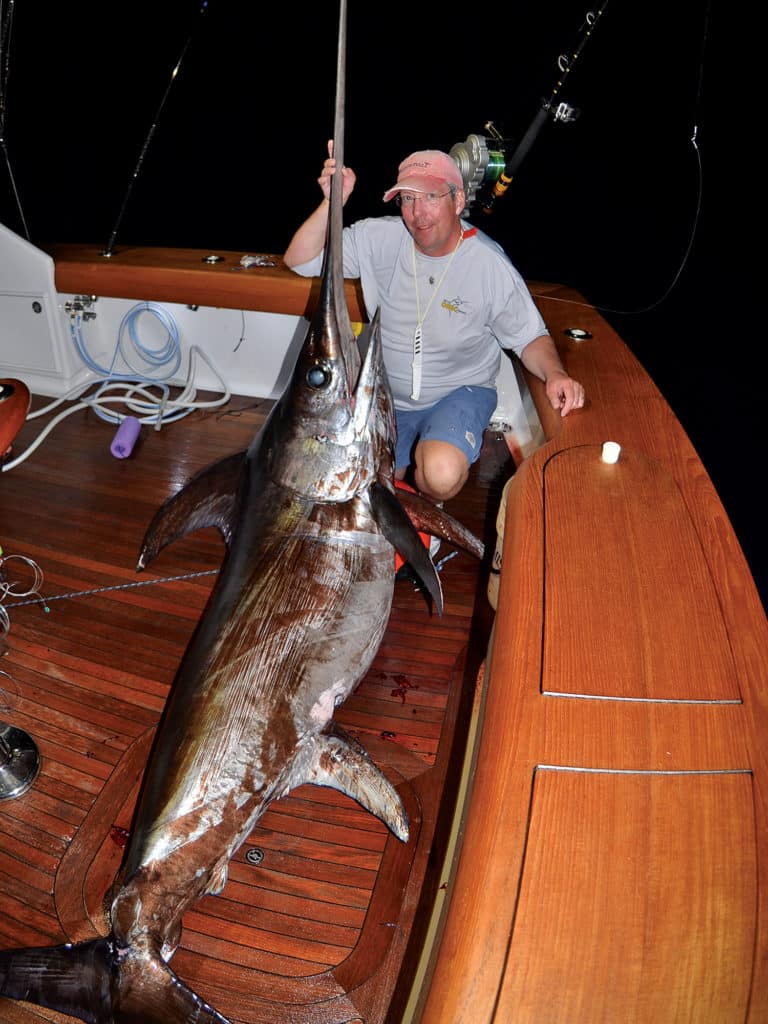
I remember the day like it was yesterday: It was June 26, 2014, out in the Atlantis Canyon, some 105 nautical miles from home in Falmouth, Massachusetts. The conditions were perfect, a bluebird day with flat-calm, cobalt-blue seas, and we were the lone boat out there, dropping a single 12-inch rigged mahimahi belly 1,500 feet down into the abyss and waiting for a bite.
To be honest, my crew and I were a bit skeptical of our chances of catching a swordfish during the day, but Jon is a friend, and we wanted to give his dream an honest chance of becoming a reality. Staring at rod tips hoping to see a bite is boring, and none of us really expected to do much more than hang out for a couple of hours before we got into the afternoon tuna troll.
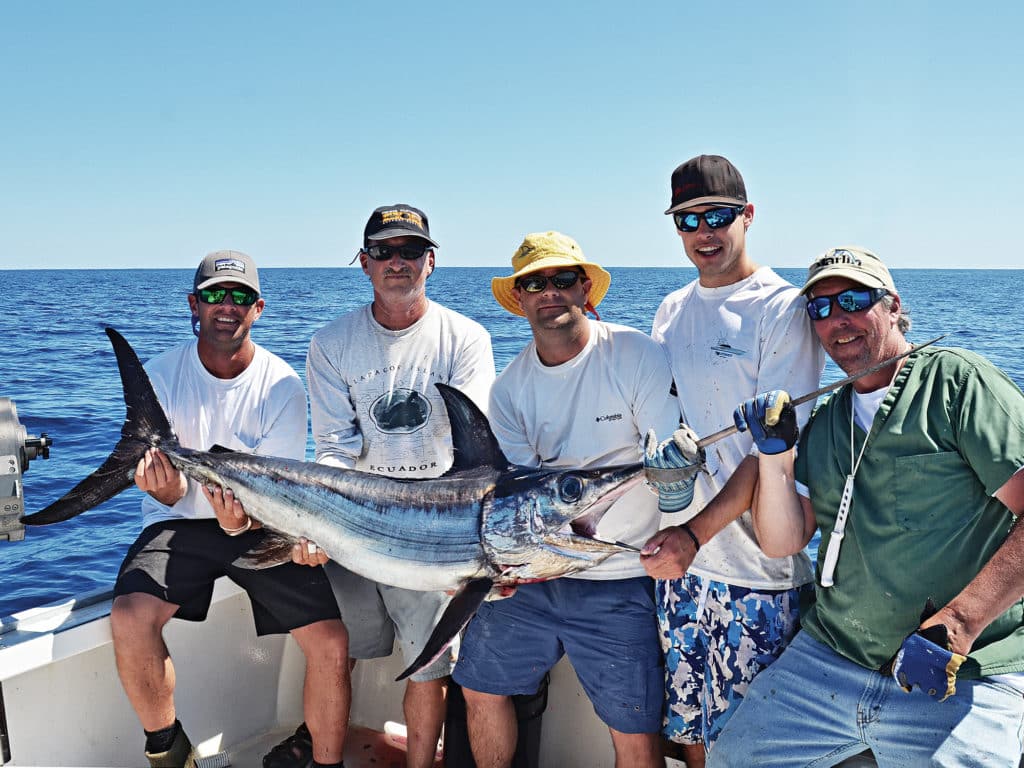
Suddenly, the rod tip twitched once and then a second time before it went down. We had a swordfish on! The fish wasn’t huge, a 64-incher in the 100-pound range, but it stayed buttoned all the way to the surface. After we gaffed the fish and brought it on board, we realized that we were the first crew in the Northeast (that we know of) to successfully deep-drop for a daytime swordfish. Witnessing the swordfish come up angry and slashing at the surface while being lit up purple and blue in the sunlight ignited the passion in all of us. We got swordfish fever.
A Unique Fishery
The Northeast Canyons are a series of notches in the continental shelf 75 to 125 miles off the coast that run all the way from New Jersey to Nova Scotia. The blue water spinning off the hot Gulf Stream 100 miles to the south intersects with “the edge” and creates currents, temperature breaks and a world-class pelagic ecosystem — a natural fish magnet. This edge is fish-rich, with a troll bite for tuna, mahimahi and marlin, and in the past 10 to 15 years, it’s generated a continuously improving night bite for swordfish.
Back in the 1950s to 1970s, there was a glorious harpoon fishery for swordfish well inside the edge and, in some cases, even in sight of Block Island and Martha’s Vineyard. This fishery died with the increase in longlining in the ’80s and ’90s, as did almost all the reports of swordfish in the Northeast. In the late ’90s, the government began the process of banning longlines in many of the southern waters where swordfish migrated and spawned. As a result of this management change, we started seeing swordfish at night in the Northeast by the early 2000s. At the same time, innovative pioneers in Florida invented the daytime deep-drop fishery and spent the next 15 years perfecting it.

Fast forward to 2012: If you fished hard for swordfish during the night in the canyons, there was a high likelihood you’d get one. We would average a bite or two at night, and on some trips we would have a half-dozen bites. They were back! We worked hard for them and used a technical four-rod spread with perfectly rigged 12-inch squid as bait. During the trips, we repositioned the boat multiple times throughout the night to increase our chances while making short, tight drifts over prime swordfish structure, like varied contours between 800 and 1,500 feet of water a few miles down from a canyon tip or “high ground” plateaus in 1,200 to 1,400 feet surrounded by deeper water.
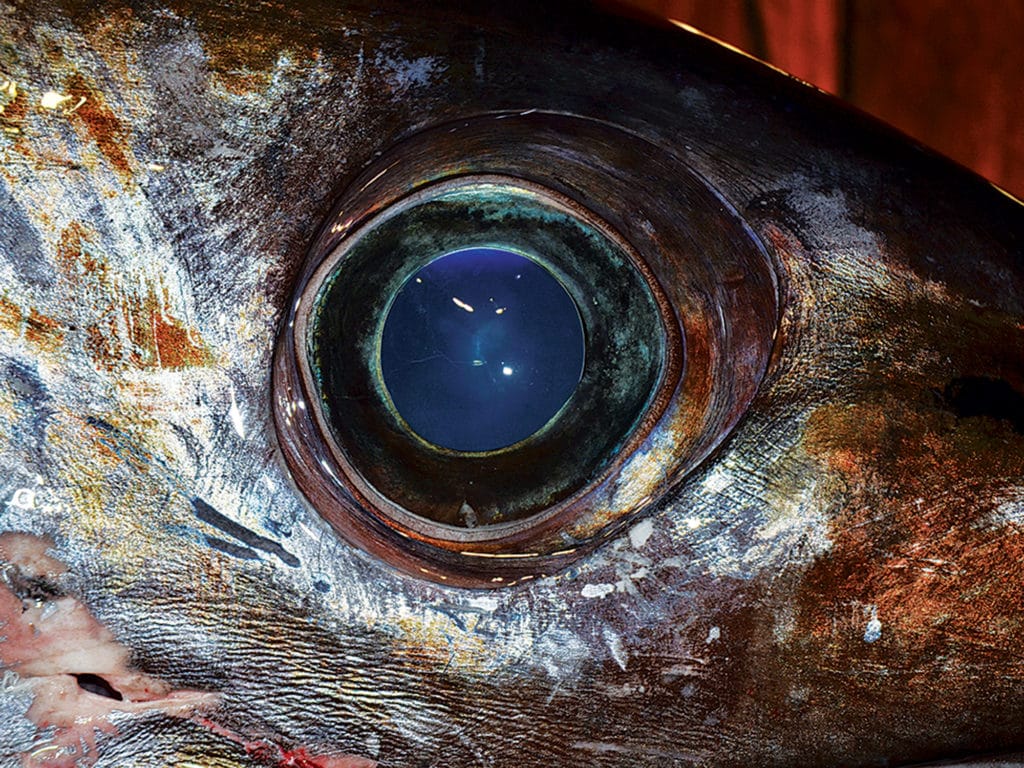
Most of the fish caught at night were small, 30 to 50 pounds at most, with the odd marker — a 100-plus-pound fish — mixed in, but that was expected as the fishery continued to recover. Every once in a while, you would hear of a boat landing a bigger one at night, but for the most part it was like fishing in a nursery.
Jon’s vision for deep-dropping followed this simple logic: If there were big fish on the bottom in Florida 1,000 miles to our south and big fish being caught on longline gear 500 miles northeast of us on the Grand Banks, there had to be big fish in the canyons, and they were likely down on the bottom where no one was targeting them.
An Epic Trip
Almost three full seasons later in September 2015, we were fishing in 1,500 feet of water in the Veatch Canyon with 76-degree clear, blue water all around us. Like most days, we were alone on a grease-calm sea, and we had trolled 5 or 6 miles south of the edge, where we marked bait and found a beeper buoy — the radio transmitter marking the end of a longline set.
We moved a half-mile to the north of the longline and set up for our first drop.
It takes a good 15 minutes after a bait is ready on the line to get it down 1,500 feet, and it also requires a few hundred yards of moving the boat to keep the bait as close to vertical as possible during that long drop. We had spent the better parts of three seasons and hundreds of drops refining our technique to be as efficient as possible. Jackson Parmenter had spent trip after trip working with Jon on making perfect bait presentations and flawless drops to master the art of the deep-drop.
This drop was close to perfect and hit bottom in 1,450 feet on the edge of a steady drop-off down below 2,000 feet. Nothing happened for the first 10 minutes, then we saw the telltale tap, tap, tap of a bite. We executed perfectly: Jackson drove the hook home with the full 60 pounds of drag that an LP S-1200 delivers, then we feathered off the drag to a safe 20 pounds as he worked the fish up and into the light. During the entire battle, the whole team performed perfectly. We got jumps and angry thrashes from this fish on the surface before we got it on the leader and quickly harpooned, gaffed and boated the 75-inch, 200-pound sword — a fish to really be excited about.
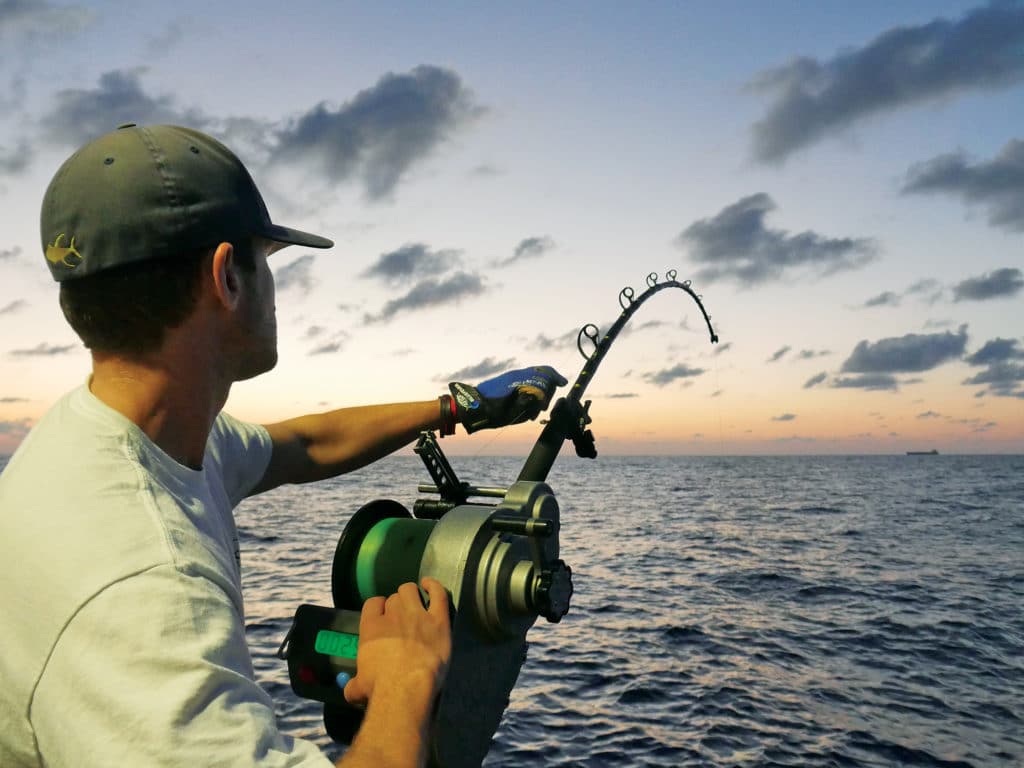
We weren’t done. On the second drop, we drifted a bait untouched across the same terrain and path from 1,400 feet down to 2,000 feet. We reset for a third drift a hundred yards to the north of the second one. Jackson never left the bait still during the drift as he constantly jigged it up and down using the LP S-1200. After finding bottom and again drifting untouched out into 2,000 feet of water, he began to pull the bait up 200 feet, and it instantly got piled on. The rod went down hard, and the line started peeling out — a dream bite where the fish eats deep and hooks itself.
Everything went perfectly on the long fight to the surface. Jackson kept the fish coming as I positioned the boat, treating it like a marlin by keeping it well out from the boat. We got the sword on the surface with 400 feet of line still out and were able to get to the 5-pound weight on the leader quickly while the swordfish was thrashing crazily on the surface, not realizing it was fighting more than just the weight. Once we got that weight off, we just had the 100 feet of leader left.
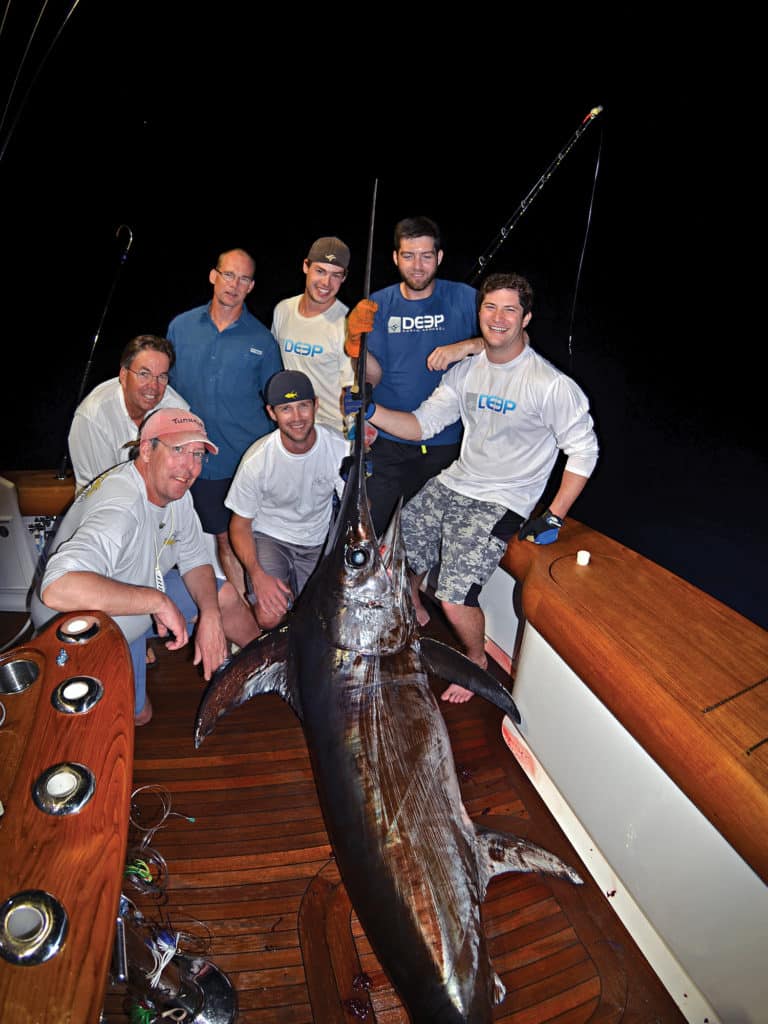
By some skill and more luck, we were able to leader the fish to the boat and get two darts and two gaffs into it. Once on deck, this fish measured 85 inches from the lower jaw to the fork of the tail — well north of 300 pounds. The three drops had produced two big fish during our 24-hour trip more than 110 nautical miles offshore. Now that is what the Northeast Canyons can produce!
Northeast Deep-Drop Secrets
The Northeast presents an entirely different set of deep-drop challenges than many tropical locations. The elephant in the room is the 100-plus-mile distance from port. That’s four hours at 25 knots, five hours at a more typical 20 knots. Time, distance, weather changes during the trip, a boat’s fuel range, sea conditions and boat stability — both underway and at drift — are all variables that must be considered in planning and executing a deep-dropping trip in the Northeast. A boat with a 30-plus-knot cruise is far less important than a comfortable and dry ride when making a canyon run.
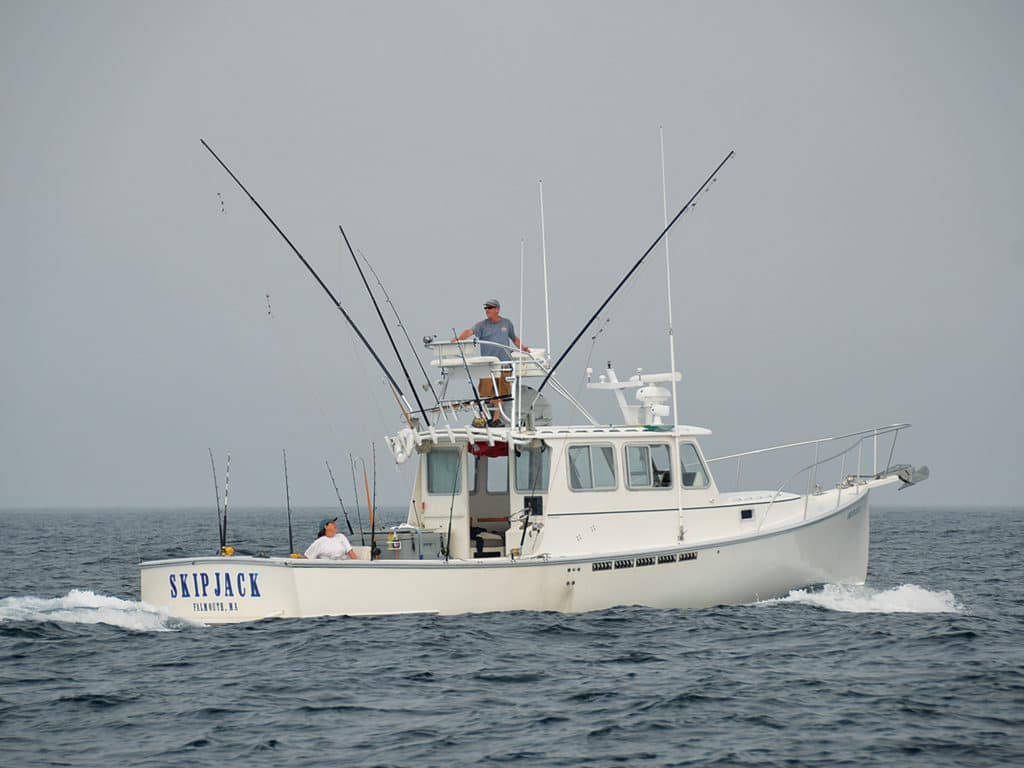
Likewise, the ratio of time fishing versus time running typically means spending a night on the boat offshore. Beanbags and open center console decks are great for a young crew if conditions are perfect, but an enclosed, air-conditioned cabin and a set of comfortable bunks make for a much more comfortable experience. That sport-fisher with the 30-foot tower may be wonderful at speed and on troll, but how well does it sit for an eight-hour night with the typical rolling 3- to 5-foot seas in the canyons?
The Northeast is rich in bottom structure. It’s easy to find both 20- to 50-foot steep ledges and 500‑foot mud slopes that fall off a plateau into the abyss. What we call the edge — the 600-foot depth line where the continental shelf ends — extends along the entire Eastern Seaboard to the Hague Line marking the Canadian border, so this provides us hundreds of miles of cuts, notches, ledges and plateaus to discover and fish. We rarely fish known and marked canyons anymore, preferring to find our own spots off the beaten path and away from the crowds.
The steep edges of canyon tips have ledges and hard bottom that can vary by hundreds of feet within a couple hundred yards. While this is enticing structure and no doubt holds swordfish, we prefer to find plateaus with muddy, sloping sides and fish that same 300- to 400-foot drop during a mile-long drift.
“The feel of a 5- to 10-pound weight hitting and sticking in mud is unmistakable.”
Our experience has been that swordfish prowl those muddy slopes for food, and we have even caught swordfish with chipped and scarred bills with bottomfish in their bellies — they apparently like to root in the mud for their dinner.
Northeast currents are wimpy to nonexistent. A 2-knot current is as fast as we have seen on fishable days, and a more typical current is around 1 knot. On flat-calm greasy days with a half-knot or less of current, we have found that we need to bump-troll the lead and bait a hundred yards at a time to allow the bait to fly up in the water column as the boat moves before it sinks back to vertical each time the boat coasts to a stop. This yo-yoing technique has produced a couple of surprise bites with the bait well up off the bottom.
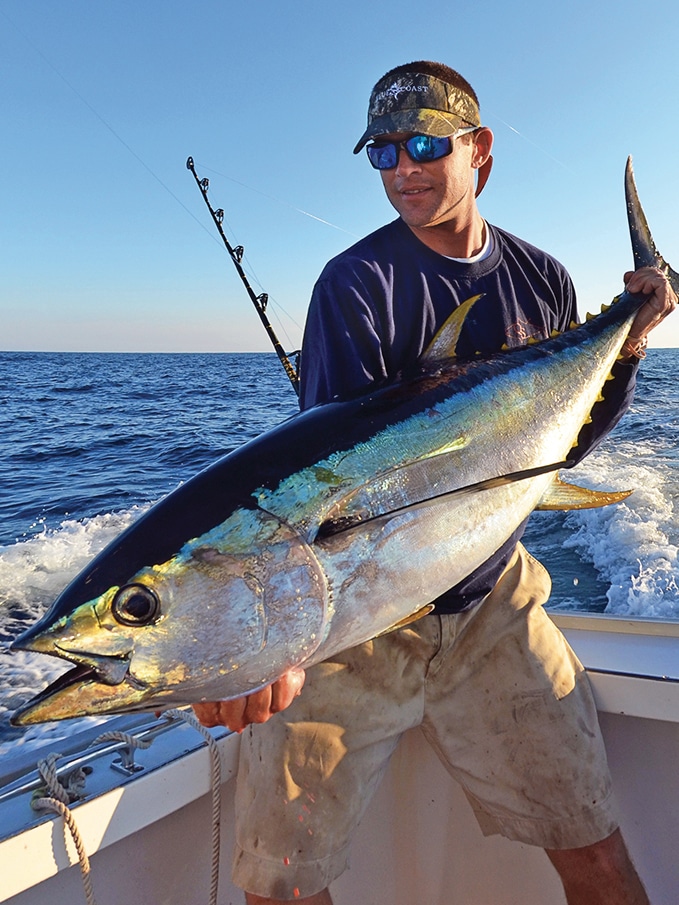
We have also found in the slow Northeast currents that constantly moving the bait elicits bites. Our baits never stay still for more than a minute; they are always being worked up 20 feet at a time or dropped back down to the bottom. We seem to get more bites right after the bait has been moved, so it’s rarely left still.
Boat positioning is also important, and we aim for a 30- to 45-minute drift between 1,400 and 2,000 feet but do adapt to the conditions. If we get bites in 1,600 feet, we tighten the drift from 1,500 to 1,750 feet. Conversely, if we don’t get bites after three drifts, we move a few miles and set up in a new position. As with all types of fishing, keep moving until you find the fish.
The Confederation of Deep-Droppers
Over the past two years, we have found ourselves working closely with friends on another half-dozen boats, loosely networking to share information and techniques. Tokatomist, Midnight Rambler, Hot Reels and Rowdy Dow are all boats we network with to learn more about this fishery. Rarely are we side by side with any of these boats on the fishing grounds, and with hundreds of miles of likely structure, we spread out to better explore and find where the fish are. After trips, we discuss techniques, baits, boat positioning, water temperature and color, and drift tactics as we mutually try to improve our ability to get on top of and ultimately land large swordfish.
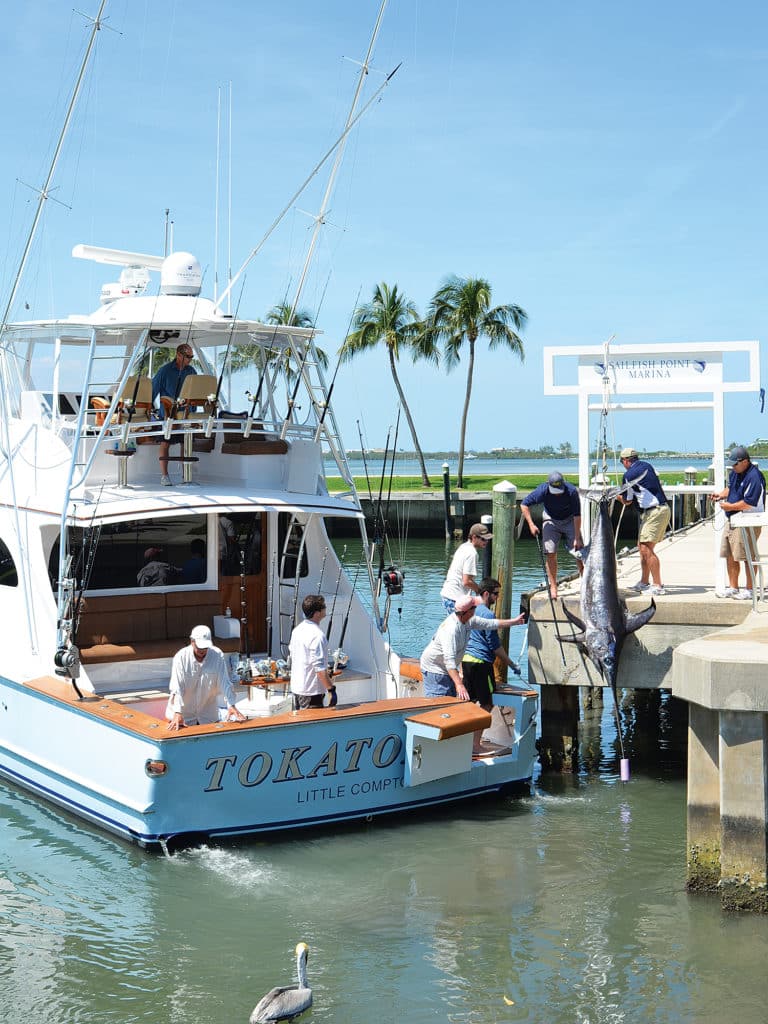
The Howd family on Tokatomist, a gorgeous 60-foot Ritchie Howell, is a team of three brothers and their parents who are pushing the boundaries of this fishery. Steve Howd spent the better part of a month working on an IGFA-legal bait-and-leader system that is attached to a Penn 70 setup with a mile of braid. He then landed the first IGFA-legal, hand-cranked swordfish during the day in the Northeast during the Oak Bluffs Classic. The Howds surprised a lot of skeptical fishermen when they showed up back at the weigh-in with a 125‑pound swordfish. Last July, Tokatomist found a notch in the canyon walls near Veatch Canyon and had an incredible trip for swordfish. Over the two-day period, the crew made a dozen drops, had 10 bites and landed or released three swords.
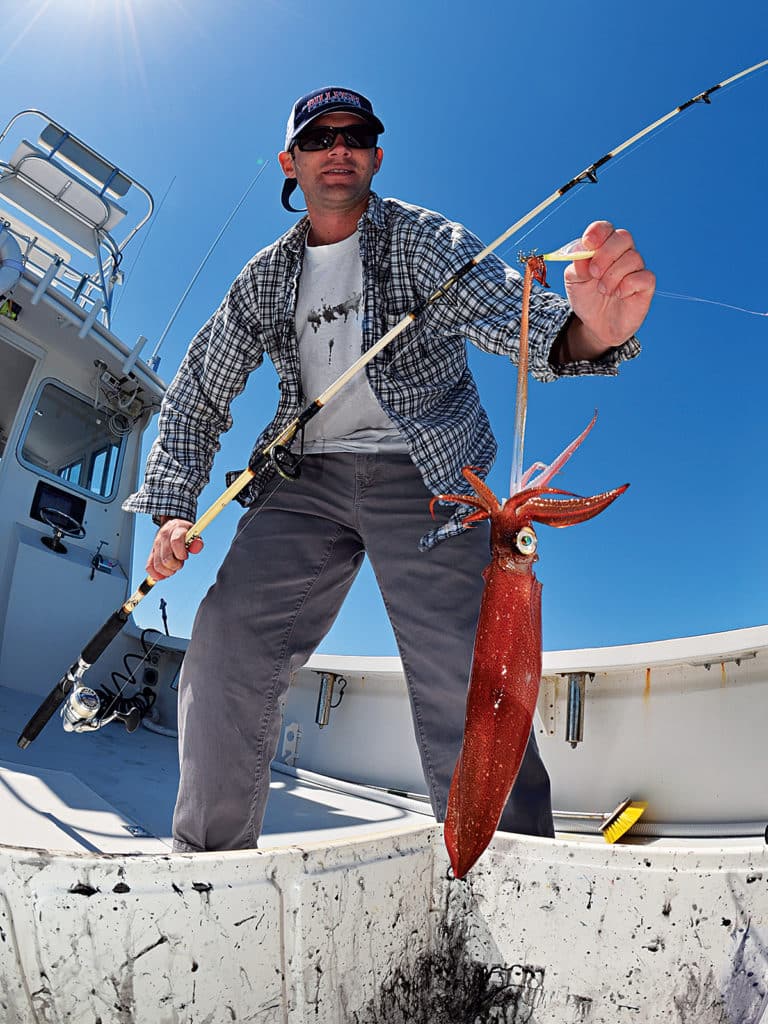
Lou DeFusco of Hot Reels is also innovating with fast boats and lighter tackle to make a charter business out of this nascent fishery. He runs 80 to 90 miles in his 38-foot Donzi from Point Judith, Rhode Island, to do 20-hour predawn-till-evening day trips, and he successfully catches swordfish by day as part of these charters before he runs the clients back to port the same evening.
Jim and Jay Noon, a father-and-son duo on Midnight Rambler out of Point Judith, have been deep-dropping for two years. In addition to their share of swordfish, they have also landed a couple of 200-pound bigeye tuna off the bottom in some 1,500 feet of water. Bill Center on Rowdy Dow got swordfish religion when Jon Pilcher made the long drop of a single bait in Hydrographer Canyon last October and hooked up within 15 seconds of the bait hitting bottom.
Why Not Try?
Deep-dropping is a serious investment in both tackle and time. The rod and reel, line and leader, and terminal tackle add up quickly. However, the same setup can be put to other uses offshore like running a dredge and deep-dropping for tilefish and wreckfish, or even used as a planer rod. If you have any sort of canyon fishing experience, you know those high-sun, calm midday hours can be glacially slow on the troll. You are out there anyway, so give it a try during some lazy August afternoon when the tuna are deep. Just roll out to 1,500 feet, find a spot, drop a rigged bait down and see what happens.
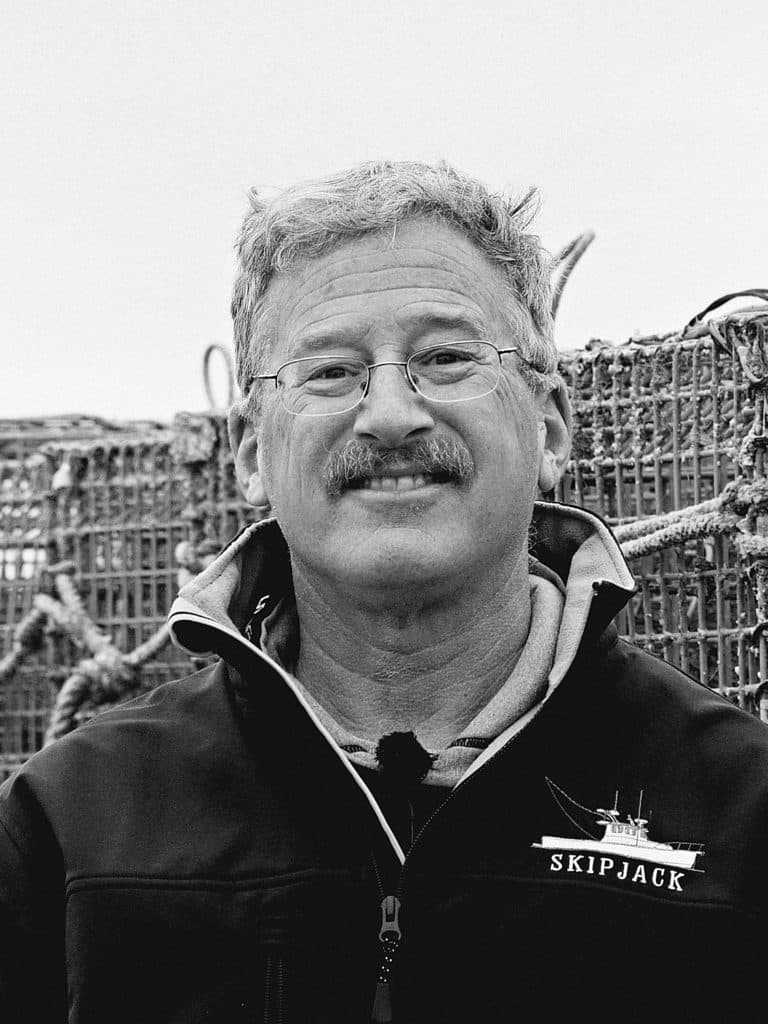
About the Author:
Capt. Larry Backman has fished on his own boat, Skipjack, in the Northeast Canyons for almost 20 years and is completely focused on finding that 500-pound daytime swordfish.







